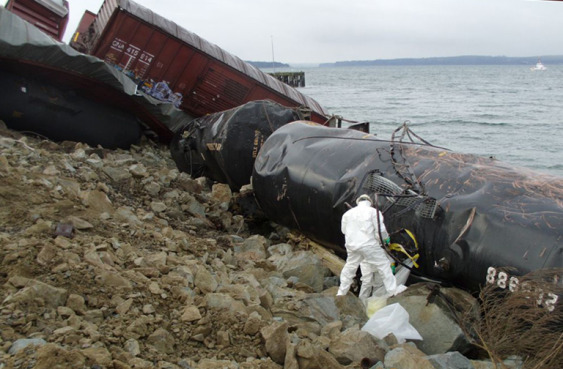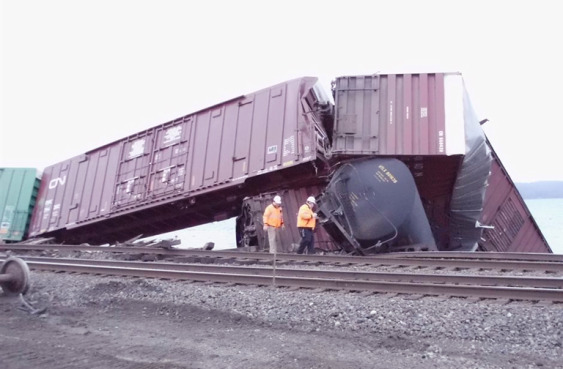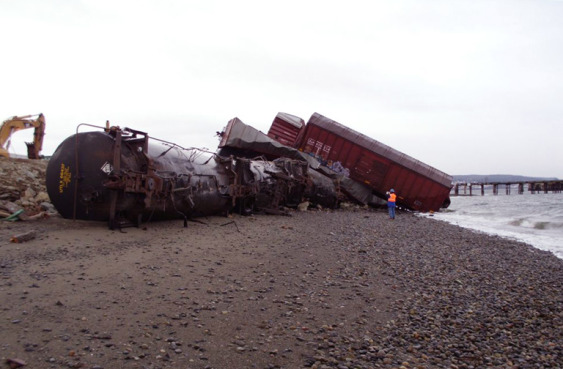If you’ve ever wondered how an oil train derailment might go down on the shores of Puget Sound, it might look a bit like the winter night derailment in 2011 that spilled sodium hydroxide on a beach at Chambers Bay south of Tacoma. It was hardly the kind of disaster that has resulted from oil trains derailing, but it still makes for a rather instructive lesson in how these things happen.
Sodium hydroxide, more commonly known as lye, is used as a chemical base in the production of pulp and paper, textiles, drain cleaners, and other products. (It’s also the major ingredient that makes lutefisk unpalatable.) It’s caustic, corrosive to metal and glass, and it can cause fairly serious burns. You want to be careful handling it but—notably unlike the volatile shale oil traveling daily on the very same rail line—it does not erupt into 300-foot-tall fireballs.
If it had been an oil train, things could have been much, much worse.

What happened is this: around 8 pm on February 26, 2011, a north-bound freight train derailed, sideswiping a south-bound train that was carrying (among other things) four loaded tank cars of sodium hydroxide in a liquid solution. One of those cars was damaged in the collision and leaked a relatively modest 50 gallons onto the beach before response crews plugged the leak.
At the time, of course, no one knew how serious the incident was—and things did not go smoothly that night. The 911 call went out at 8:02 and firefighters were responding by 8:10. At 8:31 the Pierce County Sheriff alerted the National Response Center, the agency that in turn notifies all the relevant federal and state agencies. The Department of Ecology learned of the accident at 8:52.
By contrast, BNSF, owner of the railway and operator of the train—not to mention the nation’s leading carrier of volatile Bakken shale oil—did not contact emergency management authorities until 8:56. And then things got worse. As the government responders assembled—sheriff’s deputies, fire fighters, US Coast Guard officials, oil spill clean-up experts—they were unable to get the railway to respond to their requests for information, or even to show up at the fire department’s incident command post.
By 11:00, three hours after the accident, the responders held their incident briefing to plan how to enter the site yet they still were unable to get BNSF officials to appear. According to Ecology’s official account, “local, state, and federal responders did not know who was participating on BNSF’s response team, their level of training nor their plan of action.”

Finally, at 11:45, almost four hours after the derailment and still without a line of communication to BNSF, local fire fighters moved into the scene. Not until 11:50 did a railway representative show up and at that point responders were finally able to establish reliable communication with the railroad. But it was almost too late: just as the fire fighters were entering the scene, BNSF began moving rail cars on the site, putting them directly into harm’s way.
Local and state responders were eventually able to secure the site and clean up the material. Yet it took days to accomplish, during which time several high tides inundated the spill area. And the story wasn’t over: a few days later, on March 1, a contractor for the railway spilled another 100 gallons of sodium hydroxide when the equipment operators lost control of a damaged tank car they were removing from the shoreline.

For jeopardizing incident responders, and for failing to coordinate with state agencies as required under Washington law, Ecology fined BNSF $3,000. The state also sent the railway a bill for $6,370 to cover the response and clean up costs. (By way of comparison, BNSF regularly reports quarterly earnings in the billion-dollar range.)
The Chambers Bay derailment should be seen as a cautionary tale because it all could have been much worse if the train had been loaded with 3 million gallons of Bakken shale oil, a typical quantity for the several oil trains that pass over that very same rail line several times a day. Not only might the oil explode catastrophically—as it has on at least four occasions recently—but it would almost certainly contaminate the Sound and beaches that the tracks run alongside. It’s worth noting too that the incident occurred directly adjacent to the Chambers Bay Golf Course, which will be hosting the 2015 US Open and a projected 235,000 fans.


Comments are closed.